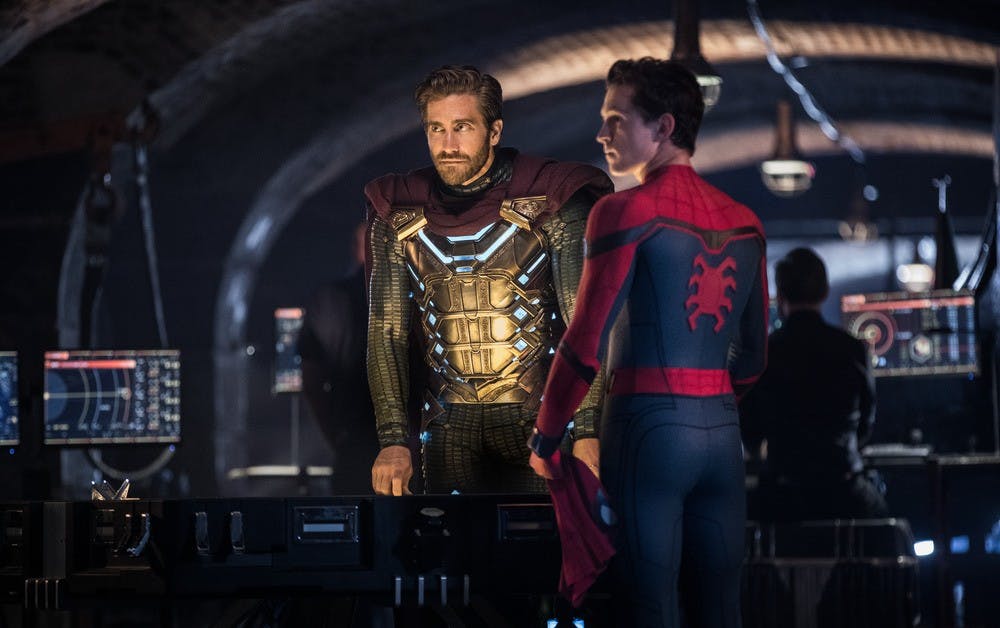Spider–Man: Far from Home always had some big shoes to fill. Released on July 2, the film is not only the first one to set after Avengers: Endgame but also the beginning of the Marvel Cinematic Universe’s Phase Four of films. It also continues the story of Peter Parker, aka Spider–Man, one of the most beloved superheroes of all time. The filmmakers, then, were tasked with creating both a standalone Spidey film and a satisfactory follow–up to the second biggest film ever. While many past Marvel movies have done both, Far from Home falls a little short. Filled with awesome action pieces and fun teenage antics, it's an enjoyable film that also feels at odds within the MCU.
The film opens with the familiar title sequence set to Whitney Houston’s “I Will Always Love You.” It fades into a hilariously unprofessional memorial video, made by Peter’s high school, for our recently deceased Marvel heroes. Creating the perfect mix of kitschy and earnestness that fans love about Marvel films, it also sets the tone for the rest of the movie, which centers around a clash between superhero and teenage life that—although sanitized—feels fun and endearing.
Tom Holland’s Peter Parker, with his bumbling charisma and agility, is also quickly becoming the Spider–Man in people’s hearts. Zendaya—playing the love interest MJ with a sardonic attitude and hidden insecurities—brings a fresh take to the classic character. As Peter tries to ask MJ out throughout the film, their chemistry is developed with an adorable awkwardness. The film’s highlight, though, comes from Peter’s best friend, Ned, and classmate, Betty. Getting together on the class’s plane ride to Europe, and breaking up by the trip’s end, they are a delightful reminder of how ridiculous high school can be even without superhero problems.

Far from Home’s other emotional conflict comes from the death of Tony Stark, Iron Man, in Endgame. In order for Spider–Man to replace him as one of the main heroes tent-poling the MCU, the film thrusts Avenger–level problems at Peter. But, even as it follows his struggles with accepting this responsibility, it smartly differentiates between Peter and Tony. In a great moment before the finale, Peter works on his suit in the same tech–genius fashion as Tony. AC/DC’s “Back in Black”—Tony's intro song in Iron Man—plays, and he yells out, “I love Led Zeppelin!” Spider–Man might be the “new” Iron Man in the MCU, but they are still very different.
Far from Home also never skimps on the action—from a trippy montage that sees Spider–Man (and the audience) trapped by illusions, to a final battle that shows Peter conquering them. The latter is a cool, new exploration of the famous Spidey Sense—or as the movie calls it, “Peter tingle.”
But many of the best moments in Far from Home are undercut by what has been done elsewhere, and better, in the MCU. In the film’s main twist, Mysterio and accomplices are revealed as villains created by Tony’s past. However, we saw Tony deal with this exact situation in Iron Man 3. And if Far from Home intends to show Peter dealing with his mentor’s imperfections, it fails to follow up. A pep talk by Happy—Tony’s best friend—merely touches on his past mistakes, and Mysterio’s origin is barely mentioned again. Far from Home wants to use Tony’s death to push for Peter’s growth, but its overly reliant on omnipresent mural arts, visual parallels, and emotional deliveries by the actors that—although touching—leaves the film empty.
The film also deals with how technology—specifically the army of drones that Tony entrusted to Peter—can be misused in the wrong hands. An admittedly hilarious scene even has Peter using the tech to spy on (and almost accidentally nuke) his classmates. Yet, Captain America: the Winter Soldier has already covered—to critical acclaim—how such surveillance and military power is inherently dangerous. When Peter regains control at the end of the film, through his victory over Mysterio, it feels like a step back for a franchise so concerned with moving forward.
Far from Home is burdened by the enormous contexts of the MCU. Even when the story is moved to Europe, in a world where Earth has been attacked countless times, its beats feel unwittingly familiar. And with Endgame still fresh in people’s minds, its ramifications—aside from Tony’s death—are played mainly for laughs. While we can’t expect grand philosophical treatises from Marvel on the emotional and logistics nightmare of people returning five years after disappearing, the way they were glossed over in Far from Home shows a lack of continuity uncharacteristic of the MCU. The conversation between Peter and Nick Fury on the whereabouts of the other Avengers—a fun trailer moment—is also the extent of explaining why not one hero (even the ones on Earth) helped when monsters are destroying Europe.
Critics have often compared the MCU to a long, high–budget TV show, and so far, this approach has worked. However, as its roster grows, and its heroes assemble more frequently, it became harder to tell new, separate stories. How many times can a villain come from a hero’s past, and the world be saved, and why are only some people trying to save it? The most recent Marvel movies, aside from The Avengers ones, have sidestepped this by limiting the threat (Ant-Man and the Wasp) or making a prequel (Captain Marvel). But in Far from Home, the plot fatigue and distractions are apparent. The focus of the MCU has long shifted from the development of its individual heroes to cross–overs, cameos, and universe continuity. Now, it struggles to craft a story unique to Spider–Man alongside our expectation for these things.

